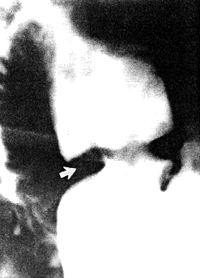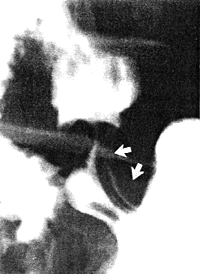



Go to chapter: 1 | 2 | 3 | 4 | 5 | 6 | 7 | 8 | 9 | 10 | 11 | 12 | 13 | 14 | 15 | 16 | 17 | 18 | 19 | 20 | 21 | 22 | 23 | 24 | 25 | 26 | 27 | 28 | 29 | 30 | 31 | 32 | 33 | 34 | 35 | 36 | 37 | 38 | 39
Chapter 13 (page 59)
Torgersen (l942) stated categorically that a distinction should be made between the terms
"pyloric aperture or orifice" and "pyloric canal". In his view "pyloric orifice" denotes the
central aperture in the pyloric ring at times when the sphincteric cylinder is relaxed or
expanded (Fig. 13.12A). In adults it is approximately 5.0 to 10.0 mm in
diameter and 4.7 mm in width (the width being equal to that of the ring (Chap. 11).
"Pyloric canal" denotes the thin channel, 2.0 to 3.0 mm in diameter and 2.0 to 3.0 cm in
length, which is formed during maximal contraction of the sphincteric cylinder (Fig.
13.12B). The pyloric canal, in other words, is a functional entity which is
fully formed only during maximal contraction of the cylinder. Should "pyloric canal" be
used for both entities, it is clear that the pyloric canal could be both short and long in the
same subject, depending on the stage of contraction of the cylinder. Torgersen advised
that these terms should be used with special care. In the present context the terms
"pyloric aperture" and "pyloric canal" are used according to his guidelines.
An attempt to correlate closure and opening of the pyloric aperture, as seen at radiology,
with the muscular anatomy as described by Cunningham (l906), Forssell (l913) and
Torgersen (l942), has been made (Keet l962).
The findings showed that in each pyloric cycle, at a stage when the sphincteric cylinder is
relaxed (i.e. expanded), the aperture is seen to contain barium or air, i.e. it is patent, and
its diameter can be measured (Fig 13.12A). When contraction of the
cylinder commences, the diameter of the aperture may widen or narrow marginally (see
later). With continuing contraction of the cylinder the diameter of the aperture decreases,
and with maximal contraction, at a stage when the pyloric canal is fully formed, the
aperture is closed (Fig. 13.12B). This process of dynamic muscular closing
of the aperture is seen regularly during maximal, cyclical contraction of the sphincteric
cylinder; it was not seen during incomplete contraction of the cylinder. It is one
mechanism by which the aperture is closed and should be differentiated from mucosal
closure and from passive closure (see later).
A |  B B |
| Fig. 13.12.
A Pyloric sphincteric cylinder expanded. Pyloric aperture (arrow) widely patent.
B Maximal contraction of sphincteric cylinder with formation of pyloric canal (arrows).
Pyloric aperture closed
|
From time to time a patient would arrive after having had a full breakfast. As a general
rule these patients would be asked to come back at another time. However, in 20 of these
patients it was decided to examine gastric contractions in the presence of a mixed solid
and liquid meal. Each was asked to swallow four mouthfuls of barium suspension. In all
cases typical pyloric cycles with maximal contraction of the sphincteric cylinder were
seen. The impression was that contractions occurred at a more regular rate than in liquid
"meals". Also, the range of movement appeared to be greater, with a greater degree of
expansion and tight contraction during formation of the pyloric canal.
It was concluded that the character or nature of the contractions was the same in liquid
and mixed solid and liquid meals. However, the rate of contraction was more regular,
and contractions appeared to be more vigorous, in the latter.
Previous Page | Table of Contents | Next Page
© Copyright PLiG 1998








 B
B